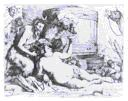Jusepe de Ribera
Spanish
(Jativa, Spain, about 1591 – 1652, Naples, Italy)
Jusepe de Ribera, also called "lo Spagnoletto" (or little Spaniard) was the greatest painter of the Neopolitan Baroque era, and a master of early seventeenth-century realism. Although he was Spanish, born near Valencia, Spain, he lived and worked for most of his life in Naples when it, and a sizable part of Italy, was ruled by the Spanish. Ribera arrived in Italy between 1607 and 1614, and resided for periods in Parma and in Rome. The majority of his career was spent in the Southern city of Naples, where his paintings were produced for Spanish patrons there and for export to Spain. His painting style reflects the influence of the Caravaggisti, followers of Michelangelo Merisi da Caravaggio (Italian, 1571–1610), and the sublime color of Guido Reni (Italian, 1575–1642). Ribera’s interest in printmaking dates almost exclusively to the decade of the 1620s and was very short-lived; he had created all but four of his known etchings by 1622. He was an exceptional draftsman, and as a printmaking medium etching most closely replicates the fluidity of the drawn line. Also, etching did not require mastery of the technical skills needed for engraving or woodcut printing. Unlike printmakers such as Rembrandt (Dutch, 1606–1669) who sought varied tonal effects by varying the inking and printing of his plates, Ribera was not inclined to re-work his plates; the effects he achieved were the direct result of his talents as a draftsman. Although his print oeuvre was small, the influence of these works is apparent in the number of paintings by European artists later in the seventeenth century that replicate the compositions in these etchings. It is possible that Ribera adopted printmaking specifically as an effort to promote his work as a painter, and once his reputation was established he saw no further need to create prints.
See Johnathan Brown, “The Prints and Drawings of Ribera,” in Jusepe de Ribera: lo Spagnoletto, 1591-1652 (Fort Worth: Kimball Art Museum, 1982).
Spanish
(Jativa, Spain, about 1591 – 1652, Naples, Italy)
Jusepe de Ribera, also called "lo Spagnoletto" (or little Spaniard) was the greatest painter of the Neopolitan Baroque era, and a master of early seventeenth-century realism. Although he was Spanish, born near Valencia, Spain, he lived and worked for most of his life in Naples when it, and a sizable part of Italy, was ruled by the Spanish. Ribera arrived in Italy between 1607 and 1614, and resided for periods in Parma and in Rome. The majority of his career was spent in the Southern city of Naples, where his paintings were produced for Spanish patrons there and for export to Spain. His painting style reflects the influence of the Caravaggisti, followers of Michelangelo Merisi da Caravaggio (Italian, 1571–1610), and the sublime color of Guido Reni (Italian, 1575–1642). Ribera’s interest in printmaking dates almost exclusively to the decade of the 1620s and was very short-lived; he had created all but four of his known etchings by 1622. He was an exceptional draftsman, and as a printmaking medium etching most closely replicates the fluidity of the drawn line. Also, etching did not require mastery of the technical skills needed for engraving or woodcut printing. Unlike printmakers such as Rembrandt (Dutch, 1606–1669) who sought varied tonal effects by varying the inking and printing of his plates, Ribera was not inclined to re-work his plates; the effects he achieved were the direct result of his talents as a draftsman. Although his print oeuvre was small, the influence of these works is apparent in the number of paintings by European artists later in the seventeenth century that replicate the compositions in these etchings. It is possible that Ribera adopted printmaking specifically as an effort to promote his work as a painter, and once his reputation was established he saw no further need to create prints.
See Johnathan Brown, “The Prints and Drawings of Ribera,” in Jusepe de Ribera: lo Spagnoletto, 1591-1652 (Fort Worth: Kimball Art Museum, 1982).



